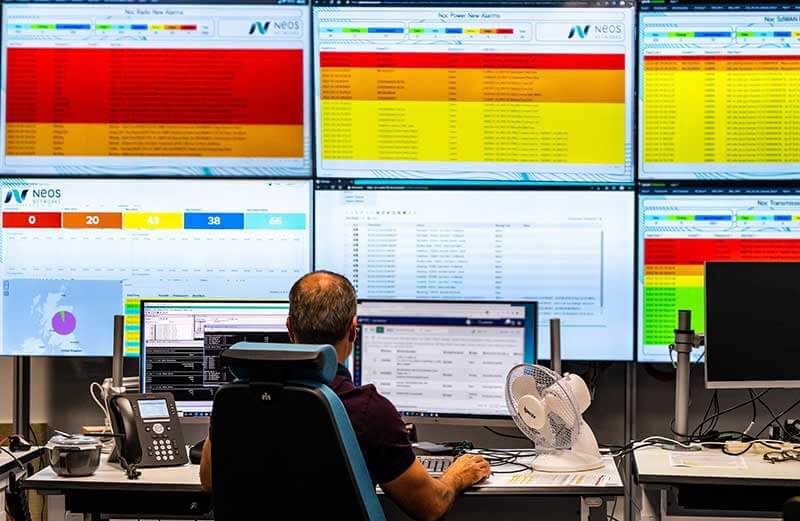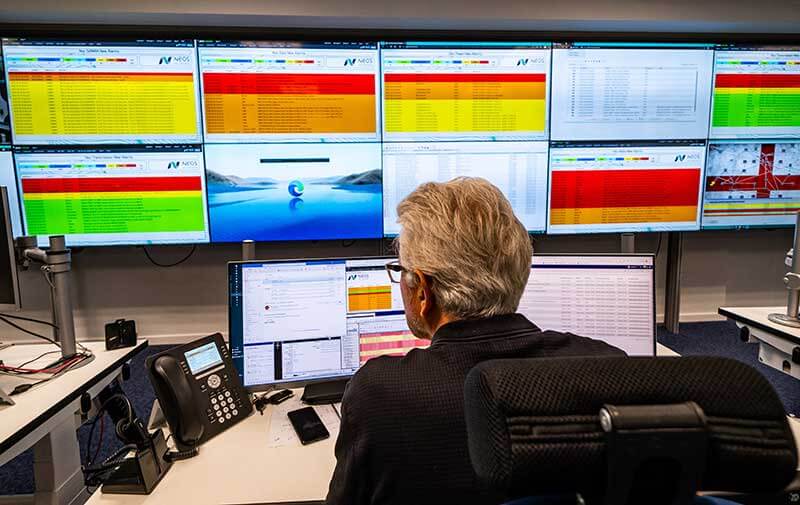- Home
- Resources
- Blog
- Home
- Business General
- What is a network operations centre (NOC)?
What is a network operations centre (NOC)?
A network operations centre is a vital hub that manages a company’s network infrastructure. Learn how it works and why it’s crucial to maintaining the performance and security of large networks
- Neos Networks
- Business General ,

- What is a network operations centre (NOC)?
- How does a NOC work?
- Benefits of a NOC
- NOC for critical networks
What is a network operations centre (NOC)?
A network operations centre, or NOC (pronounced like “knock”), is a central hub where network engineers manage and maintain a company’s network infrastructure. Typically, it’s a secure room with a video wall displaying network maps, critical platform alerts, call statistics and other critical network parameters. Facing the video wall, NOC staff sit at rows of workstations, monitoring the network's operations.
Industries that need reliable, constant connectivity, such as the energy sector, telecommunications, emergency services and financial institutions, use NOCs to maintain their critical networks. However, any organisation with an extensive network may use a NOC, either in-house or run by a third-party network service provider.
For example, at Neos Networks, our NOC monitors our UK-wide high capacity network round the clock, ensuring our customers’ mission-critical networks run smoothly, whatever happens.
Monitoring 24/7 at the Neos Networks NOC

How does a NOC work?
A NOC works like your central nervous system. Just as your brain manages your vital organs to keep you healthy, a NOC monitors critical network elements, customer services and third-party integrators to maintain your network’s health.
Working 24/7, 365 days a year, NOC staff use specialist tools to identify faults, coordinate incident resolution and optimise network efficiency. In addition, a NOC may monitor alerts for unauthorised access and other cyber threats to ensure network security.
NOC functions
A network operations centre performs several vital tasks to maintain a network. The main functions of a typical NOC include:
- Monitoring: A NOC continuously monitors network alarms and the stability of vital network components such as power, transmission nodes, switches, routers and other managed devices.
- Optimisation: Analysing network data and performance, NOC engineers take steps to manage capacity and enhance network efficiency to meet changing demands.
- Troubleshooting: When a fault or outage occurs, NOC staff investigate and, if necessary, coordinate fault resolution with engineers in the field to minimise network downtime.
- Maintenance: When planned maintenance takes place, the NOC monitors the network for impacts, tracks the progress of the work and ensures any unexpected impacts are resolved.
- Security: NOC staff track security alerts and take action to prevent unauthorised access, DDoS attacks and other cyber threats.
- Reporting: A NOC may compile reports on network performance, troubleshooting and network configurations for network management and compliance purposes.
Overall, a NOC is a first line of defence against network disruption and security threats, ensuring that a network remains operational round the clock. By working closely with a company’s help desk or directly with customers, NOC staff respond quickly to customer requests, resolving issues and minimising downtime.
NOC processes
To respond to incidents efficiently, NOCs typically prioritise tasks and organise teams into tiers to tackle them.
For example, at the Neos Networks NOC, we classify events by severity and impact to drive priority: from P1 for the most critical issues down to P4 for low or no impact events. Faults are worked on collaboratively between multiple teams:
- Tier 1: The triage team receives calls, logs support tickets and classifies incidents, performing initial diagnostics to determine the cause of the fault and the next action.
- Tier 2: The on-net technical team analyses any tickets escalated from Tier 1, responds to network alarms, resolves issues with network devices and works with customers to rectify faults.
- Tier 3: Multiple engineering teams build or repair physical infrastructure in the field, configuring services and resolving escalated incidents for customers.
As customer service is our priority at Neos Networks, we use the ‘SANE’ method when updating customers during a fault:
- S – Situation: Outline the current situation, for example, the circuit ID number, fault type and location affected.
- A – Action: Set out what we’ve done so far and the current outcome.
- N – Next Steps: Log what’s happening now and what we’ll do to resolve the issue.
- E – Expectation: Clearly explain the following steps to customers and make sure we do them within the agreed timeframe.
By staying SANE, we ensure that faults are resolved as soon as possible and that customers are always informed of progress.
Staff in action at the Neos Networks NOC

Benefits of a NOC
A network operations centre offers several advantages for organisations that manage large networks. Among the key benefits are:
- 24/7/365 monitoring: As a NOC operates round the clock, it can respond to incidents as soon as they occur, regardless of the time of day.
- Efficient troubleshooting: When a fault or outage occurs, a NOC team follows established procedures to resolve it promptly.
- Enhanced network performance: By actively monitoring network metrics, NOC analysts can spot bottlenecks and manage capacity to optimise network efficiency.
- Increased reliability and availability: A NOC can seamlessly deploy alternative routes when an issue occurs to minimise network disruption.
- Enhanced security: A NOC team monitors network alerts for security breaches or other cyber threats and takes timely action to counter them.
- Scalability and network management: As a centralised hub, a NOC makes it easy to scale up or down operations as demand changes.
In short, a NOC plays a crucial role in maintaining the performance and security of your IT or network infrastructure. However, your business might not have the expertise or resources to run your own network and NOC.
NOC for critical networks
If you’re looking to boost your business’s network for the future, choosing a network service provider you can trust is essential. As a Critical National Infrastructure provider, we’ve designed our UK-wide network and NOC with resilience to run Britain’s vital networks.
We have two NOCs – one in operation 24/7, 365 days a year and one “dark” NOC in reserve. Our commitment to our customers is clear from the numbers:
- Around 95% of customers' calls are answered within our target of 20 seconds.
- Our relationship NPS score measuring customer satisfaction was +42 in 2023-24, well above the industry standard.
Unlike other providers, our Tier 2 on-net technical team often liaise directly with customers to resolve faults. Together with the Tier 3 engineering and field teams, they often go above and beyond, making connectivity work for our customers.
For example, following alarms received at our NOC earlier this year, the Tier 2 team swiftly dispatched field engineers to the remote and windswept Cruachan radio station in Scotland. They expected they would have to simply reboot equipment for the radio link to recover.
Instead, they found the microwave dish had blown off the tower in gale-force winds resulting in a much more complex fix plan. Working around the clock across the weekend, they were able to source a new dish and had it installed and services back up and running in no time.
If you’re looking for high capacity connectivity you can trust for your business or customers, get in touch. We’ll be happy to make connectivity work for you, whatever the future brings.
RELATED PRODUCTS
You might also like
We can connect you anywhere in the UK
Discover our network reach
Great news!
"[poscode]" can be reached with our
expanded network
Speak to a representatitive to discuss your options
Contact usLearn about our prices using our online tool, LIVEQUOTE
View LIVEQUOTESorry
"[poscode]" can not be reached with our
expanded network
Speak to a representatitive to discuss your options
Contact usLearn about our prices using our online tool, LIVEQUOTE
View LIVEQUOTE



